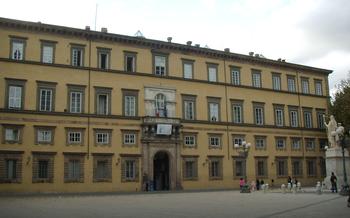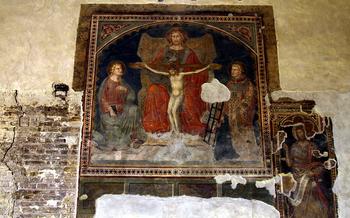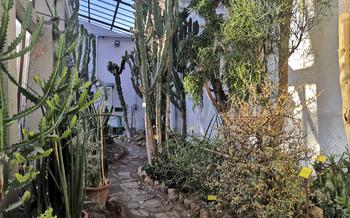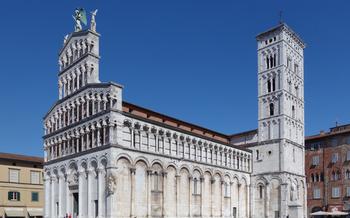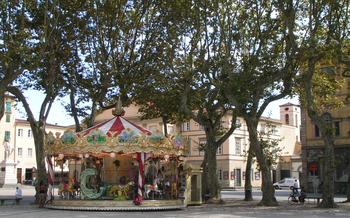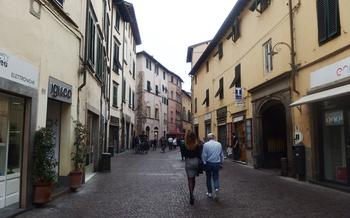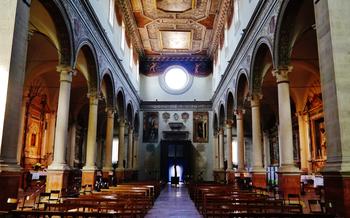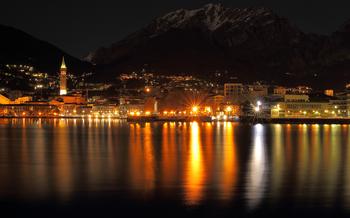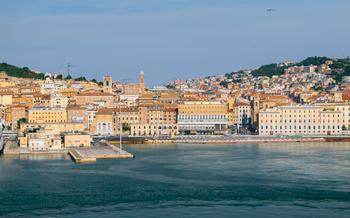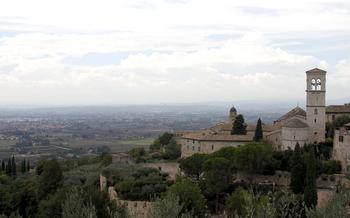
Church of San Pietro Somaldi
- Architectural Marvel
- History and Legacy
- Interior Beauty
- Religious Significance
- Art and Frescoes
- Cultural Importance
- A Place of Pilgrimage
- Somaldi Family Legacy
- Restoration and Preservation
- Local Traditions
- Nearby Attractions
- Accessibility and Transportation
- Photography and Videography
- Insider Tip:
Architectural Marvel
The Church of San Pietro Somaldi stands as a testament to the architectural brilliance of the 12th century. Its unique design blends Romanesque and Gothic elements, creating a harmonious and visually stunning edifice. The exterior boasts intricate carvings and bas-reliefs that depict scenes from the Bible. The bell tower, a prominent feature of the church, rises majestically above the city skyline, its graceful arches and delicate tracery reaching towards the heavens. The church's façade, with its elegant portal and rose window, invites visitors to step inside and explore its hidden treasures.
History and Legacy
In the 8th century, amidst the serene countryside of Lucca, a church dedicated to Saint Peter arose. This sacred edifice, known as the Church of San Pietro Somaldi, would embark on a remarkable journey through time, leaving an indelible mark on the city's religious and cultural tapestry. Its story is intricately intertwined with the Somaldi family, a prominent lineage whose influence would shape the destiny of this sacred space.
Through the passing centuries, the church witnessed the rise and fall of empires, the ebb and flow of artistic movements, and the unwavering faith of generations. It underwent transformations and renovations, each leaving its own distinct imprint. In the 12th century, the church assumed its current Romanesque-Gothic architectural style, a testament to the changing tastes and influences of the era.
The Somaldi family, ardent patrons of the church, played a pivotal role in its development. Their generosity and dedication ensured its continuous embellishment and expansion. The church became a symbol of their devotion and a testament to their enduring legacy. Within its walls, they found solace, celebrated their triumphs, and paid homage to their ancestors.
Interior Beauty
The interior of the Church of San Pietro Somaldi is an explosion of art and devotion. As you step inside, the nave unfolds before you, its walls adorned with stunning frescoes that narrate biblical stories and saints' lives. The ceiling is a symphony of colors, with intricate geometric patterns and heavenly scenes painted by skilled Renaissance artists.
The main altar is a masterpiece in itself, crafted from Carrara marble and adorned with intricate carvings depicting scenes from the life of Jesus Christ. The altar is a focal point of the church, drawing the eye with its grandeur and beauty. Along the aisles, you'll find elegant sculptures of saints and angels, each with a unique story to tell.
The stained-glass windows are another highlight of the church's interior. Bathed in sunlight, they create a kaleidoscope of colors that illuminate the sacred space. Each window depicts a different scene from the Bible, adding to the overall narrative of the church.
Religious Significance
The Church of San Pietro Somaldi holds immense religious significance as a place of worship and devotion. Its dedication to San Pietro Somaldi, a local saint revered for his piety and miracles, makes it a popular pilgrimage site. Pilgrims from near and far flock to the church to seek blessings, offer prayers, and pay homage to the saint.
San Pietro Somaldi, whose life remains shrouded in mystery, is believed to have been a humble monk who lived in Lucca during the Middle Ages. He was renowned for his unwavering faith, charitable acts, and miraculous healing abilities. After his death, he was canonized as a saint, and his remains were enshrined within the church.
The church also houses several religious relics associated with San Pietro Somaldi. These include fragments of his clothing, a lock of his hair, and a small wooden cross said to have belonged to him. Devotees often visit the church to venerate these relics and seek divine intervention.
Throughout the year, the church hosts various religious events and festivals in honor of San Pietro Somaldi. These celebrations draw large crowds of pilgrims and locals who come together to pray, sing hymns, and participate in processions. The most notable event is the annual feast day of San Pietro Somaldi, which takes place on June 29th. During this special occasion, the church is adorned with flowers, and a grand mass is held, followed by a festive procession through the streets of Lucca.
Art and Frescoes
The Church of San Pietro Somaldi is a treasure trove of stunning frescoes that adorn its walls and ceilings. These intricate artworks, created by skilled artisans over the centuries, depict religious scenes, biblical narratives, and the lives of saints. The most notable frescoes are found in the apse, where a majestic depiction of Christ Pantocrator surrounded by angels and saints dominates the space. The vibrant colors and expressive figures bring the biblical stories to life, creating a sense of awe and reverence within the church.
One of the highlights of the church's frescoes is the depiction of the Last Judgment, located on the west wall. The fresco portrays the separation of the righteous from the wicked, with intricate details and vivid imagery that evoke a sense of drama and emotion. The expressions on the faces of the figures, both those ascending to heaven and those descending into hell, convey the gravity of the moment.
Another notable fresco is the Madonna and Child with Saints, found in the left transept. The Virgin Mary is depicted seated on a throne, holding the infant Jesus in her arms, while saints surround her. The delicate brushstrokes and soft colors create a sense of serenity and tenderness, inviting visitors to contemplate the divine presence within the church.
These are just a few examples of the many remarkable frescoes that grace the interior of the Church of San Pietro Somaldi. Each artwork tells a unique story, contributing to the rich artistic and religious heritage of the church, and leaving visitors in awe of the creativity and devotion of the artists who created them.
Cultural Importance
The Church of San Pietro Somaldi holds a significant place in the cultural heritage of Lucca. It serves as a testament to the city's rich artistic and religious traditions. The church has played a crucial role in shaping the cultural landscape of Lucca, contributing to its unique identity.
Over the centuries, the church has been a center for religious devotion, artistic expression, and community gatherings. Its stunning architecture, intricate frescoes, and sacred relics have attracted visitors from far and wide. The church has also witnessed numerous cultural events, festivals, and processions, further enriching the cultural tapestry of Lucca.
One of the most captivating aspects of the church's cultural importance is its connection to the local community. The people of Lucca have a deep reverence for the church, considering it an integral part of their cultural heritage. They actively participate in religious ceremonies, festivals, and restoration efforts, ensuring the church's continued significance in their lives.
A Place of Pilgrimage
The Church of San Pietro Somaldi holds deep significance as a pilgrimage site, attracting numerous visitors seeking spiritual solace and connection. Over the centuries, it has become a destination for those seeking divine intervention, offering a sacred space for prayer, reflection, and contemplation. Pilgrims from near and far come to pay homage to San Pietro Somaldi, whose relics are enshrined within the church. The church's serene atmosphere, intricate frescoes, and inspiring architecture create an ideal setting for spiritual contemplation and a closer connection to the divine. During religious festivals and feast days, the church buzzes with activity as pilgrims and locals gather to celebrate and honor San Pietro Somaldi's legacy.
Somaldi Family Legacy
The Somaldi family played a pivotal role in the history and development of the Church of San Pietro Somaldi. Wealthy and influential merchants from Lucca, the Somaldi family were ardent patrons of the arts and devout supporters of the Catholic Church. They generously donated funds for the construction of the church, which was completed in the 12th century. Their contributions extended beyond financial assistance; they also played a significant role in overseeing the church's design and construction, ensuring that it reflected their refined taste and religious devotion. The Somaldi family's legacy is deeply intertwined with the church, and their patronage has left an indelible mark on its architecture, artwork, and overall grandeur. Notable members of the Somaldi family included prominent merchants, politicians, and religious figures who continued to support and embellish the church throughout the centuries. Their dedication to San Pietro Somaldi serves as a testament to their deep faith and commitment to preserving Lucca's cultural heritage.
Restoration and Preservation
Over the centuries, the Church of San Pietro Somaldi has undergone several renovations and restorations to maintain its historical and cultural significance. The most significant restoration project was initiated in the 19th century when the church was in a dilapidated state. Under the guidance of skilled architects and artisans, the church underwent extensive repairs and restoration work, including the reinforcement of its foundations, the restoration of its exterior and interior walls, and the conservation of its frescoes and artwork. In recent years, there have been ongoing efforts to preserve the church's integrity and prevent further deterioration. These efforts include regular maintenance work, monitoring of structural stability, and the use of modern conservation techniques to safeguard the church's valuable heritage. The restoration and preservation of the Church of San Pietro Somaldi are crucial to ensuring its legacy endures for future generations to appreciate and enjoy.
Local Traditions
In the tapestry of local traditions, the Church of San Pietro Somaldi holds a special place. Every year, on the feast day of their patron saint, the community comes together for a grand celebration. A solemn procession carries the revered statue of San Pietro through the winding streets of Lucca, accompanied by vibrant music and fervent prayers. Locals, dressed in traditional attire, line the streets, waving and paying homage to their beloved saint. The atmosphere is one of joy, devotion, and a deep sense of unity that binds the community together.
Nearby Attractions
In the vicinity of the Church of San Pietro Somaldi, history and culture abound. Take a leisurely stroll to the nearby Piazza dell'Anfiteatro, a unique elliptical square built on the remains of an ancient Roman amphitheater. Admire the harmony of arched facades and explore the quaint shops and cafés that line the piazza. For art enthusiasts, the Museo Nazionale di Villa Guinigi beckons. Housed in a 15th-century villa with a panoramic rooftop garden, the museum boasts an impressive collection of medieval and Renaissance art. Immerse yourself in the masterpieces by renowned artists, including Jacopo della Quercia and Filippino Lippi. Lucca's fortifications, the Mura di Lucca, are a testament to the city's rich history. These imposing walls, built in the 16th and 17th centuries, encircle the city, providing a scenic promenade atop their ramparts. Enjoy a leisurely walk or bike ride along the tree-lined paths, offering panoramic views of the city and the surrounding countryside.
Accessibility and Transportation
Reaching the Church of San Pietro Somaldi is an easy and convenient experience. Located in the heart of Lucca's historic center, it is just a short walk from the Piazza dell'Anfiteatro, one of the city's main squares. For those arriving by car, there are several nearby parking garages and street parking options. The church is also well-connected by public transportation, with bus stops located within a few minutes' walk.
For visitors with disabilities, the church is wheelchair accessible, with ramps and elevators providing easy access to all areas. Once inside, the church's spacious layout allows for comfortable movement, making it an inclusive space for all.
Photography and Videography
Photography and videography enthusiasts are welcome to capture the beauty of the Church of San Pietro Somaldi. However, it is essential to be respectful and mindful of the sacred nature of the space. Flash photography is generally not permitted as it can be disruptive to religious services and damage the delicate artwork. Tripods and other photography equipment should be used with caution and care, ensuring they do not obstruct the movement of visitors or cause any damage to the church's interior.
For the most stunning visuals, plan your visit during the golden hours of sunrise or sunset when the warm light casts a magical glow on the church's façade and surrounding architecture. If you wish to take photos or videos for commercial purposes, obtaining permission from the church authorities is always advisable.
Insider Tip:
For a unique perspective of the Church of San Pietro Somaldi, visit during the annual "Lucca Comics & Games" festival. The church's façade becomes a canvas for stunning light projections, transforming it into a magical spectacle. This vibrant event, held in late October or early November, offers a blend of art, cosplay, and medieval reenactments, creating a captivating atmosphere that brings the church's history to life. Don't miss this opportunity to experience the sacred and the fantastical intertwine in a truly unforgettable way.
